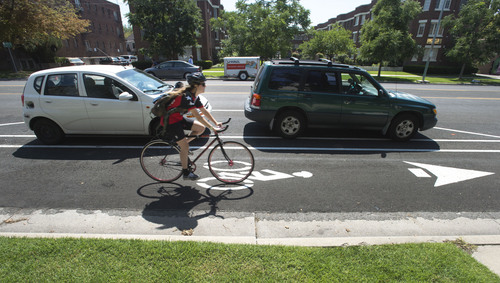This is an archived article that was published on sltrib.com in 2014, and information in the article may be outdated. It is provided only for personal research purposes and may not be reprinted.
There has been some concern within the business community, the media and the general public regarding the protected bicycle lane being installed on 300 South in Salt Lake City. The concern is that it will make the streets less safe, damage small businesses and cause numerous other problems.
There is cause for concern when a substantial change is made to a roadway. This is especially true when the design is one that only exists on a few roads across the entire country.
For those unfamiliar with the change, protected bike lanes are, essentially, sidewalks for bicycles. They are physically separated from both motor vehicle traffic and pedestrians, creating a safe space for all bicycles users.
People may ask, why go to so much effort to build protected bike lanes when a stripe of paint will do?
The short answer, paint does not stop a car.
The longer answer, a portion of the population wants to ride bicycles more frequently, but is concerned about riding near motor vehicle traffic.
A Portland State University study identified four types of transportation bicycle users. On one end of the spectrum are the "strong and fearless" (<1 percent) and the "enthused and confident" (7 percent). These are the people who are riding bicycles for transportation already. On the other end of the spectrum are those who say, essentially, "No way, no how" (33 percent).
In the middle of this spectrum lies those who are "interested but concerned" (60 percent). These people would like to ride bicycles more often, but are worried about their safety. Protected bike lanes are directed at this specific group. Creating a physical barrier adds to their subjective safety and they are more likely to ride.
Protected bicycle lanes and other designs to improve bicycle safety are often part of low-stress bicycle networks. These networks ensure that all bicycle users, regardless of their comfort level, will have a safe route in which to get around.
Research shows that protected bicycle lanes are effective at encouraging more people to ride bicycles, making roads safer for all users, and supporting local business.
People ride bicycles in greater numbers with protected bicycle lanes:
• On Washington D.C.'s Pennsylvania Avenue, bicycle volumes increased 200 percent.
• In New York City, one lane saw a 190 percent increase in weekday ridership, with 32 percent of those biking being under the age of 12.
• In Philadelphia bike traffic increased by 95 percent and decreased sidewalk riding by up to 75 percent.
Protected bicycle lanes improve roadway safety for all users:
• A three-year study of New York City's lanes found decreases in crashes with injuries (-17 percent), motor vehicle occupant injuries (-25 percent), pedestrian injuries (-22 percent), cyclist injuries (-2 percent) and total injuries (-20 percent).
Protected bicycle lanes are associated with higher retail sales:
• Portland State University researchers found that customers who arrive by bike spend 24 percent more per month than those who arrive by car.
• After the construction of a lane on New York City's 9th Avenue, local businesses saw a 49 percent increase in retail sales. In comparison, local businesses throughout Manhattan only saw a 3 percent increase in retail sales.
There is certain to be a learning curve as new bicycle infrastructure is implemented. However, we live in a state where 57 percent of the population is overweight, we are chronically plagued with poor air quality and our population is expected to double in the coming decades. There is a need for substantial changes in how Utahns get around, for the health of individuals and our communities.
Once it is completed, I would encourage drivers, bicyclists and pedestrians to experience this road configuration that is designed for people, rather than just cars.
Phil Sarnoff is executive director of Bike Utah (bikeutah.org).



